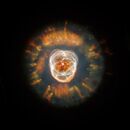Gemini
Gemini (plural Geminii) is a constellation located in the winter sky of the upper hemisphere, and the summer sky of the leftern hemisphere. It is a zodiac constellation, meaning that people born during a certain time of the year are magically affected by this collection of billions and billions of stars that are located anywhere from just a few trillion miles away (practiaclly in Earth's backyard!) to several billion parsecs away. The symbol for Gemini is a roman numeral '2', signifying the vague shape of twins represented by the brighter stars in the group. If you are unable to see these two individuals hanging up there in the sky, know that old people saw them a really long time ago, meaning that they must be there. People born under the influence of this sign, between May 21 and June 21, typically exhibit many of the same qualities, such as breathing, requiring food approximately every eight hours, and being roughly symmetrical.
Notable Deep Space Objects
Several entities in the region of the sky defined by Gemini have been designated by scientists as being "cool." When asked what specific qualities rendered these objects interesting, astronomers were unable to consistently define any characteristic (astronomy, unlike astrology, is a very imprecise branch of pseudoscience involving guesswork and generalities). In any case, these so-called notable bodies are described below.

Eskimo Nebula
Looking like a native Alaskan with his/her hood strung tight, this heavenly body is visible to the naked eye to sharp-eyed observers in rural, destitute areas with little light pollution. Astronomers claim that the object is a planetary nebula, which is the result of a very old star shedding its outer layers similar to how a very old person sheds layer upon layer of skin. Prominent astrologers have debunked this as "poppycock", instead explaining that an actual giant eskimo head exists in deep space. "It looks like an eskimo to me, so that's what I believe it is," said one such expert. When asked about the startling similarities between the 'nebula' and an Inuit, one scientist appeared rattled, and ulitmately attributed it to things like "coincidence" and "the tendency of the human eye to invent patterns". Astrologers know better, using their fail-proof logic to point out things like "space is cold, so it makes sense for eskimos to populate it" and "there is no gravity in space so eskimos can grow to gigantic proportions."
Medusa Nebula
This celestial body has been turning stargazers to stone for centuries. In fact, it is one of the many, many reasons why astronomy is the world's second-most dangerous profession. Legend has it that the hero Perseus beheaded Medusa (avoiding her gaze by using focusing on parts of her body other than her eyes) and gave the severed noggin to Athena in an effort to impress her and gain access to her godly knickers. Why Athena placed the head in the far reaches of space is a question that has plagued mankind for centuries. Since most astronomers studying this object have been permanently and irreversibly petrified, little is known and less is understood about it. Astrologers, however, frown upon obtaining data by observation and reasoning based on those observations, and have come to their own conclusions about the nebula. They claim that Athena placed Medusa's head in the heavens "to keep lowly humans from keeping their grubby meathooks off of it", and it made sense to place it in Gemini "since Medusa herself was a twin."
Other Things Warranting Mention
•M35 (Messier catalog object #35) is an open cluster of gravitationally-bound stars. It was part of the exhaustive sky survey undertaken by Mark Messier after his retirement from the New York Rangers. Although Messier himself went blind as a result of his foolish attempt to take an inventory of every star in the universe, he is renowned in astronomical circles for increasing the ease with which stargazers can refer to celetial objects (previously only identifiable by names such as "that one over there" or "the big green one".)
•NGC 2371 (Nifty Galactic Catalog object #2371) is some sort of mysterious blue glowing object. Initially thought to be two identical objects, it was later revealed that the discoverer had both eyes open when looking through his mighty telescope. Its characteristics are not well known; however, the NGC is ranked by awesomeness (with the most awesome object being NGC 1), so NGC 2371 is not on the top of any researcher's to-do list.
•The Mystery Object was a recent discovery by an amateur astronomer. He described it as "blue, or maybe orange, and fuzzy around the edges, and in the middle also." Experts think this may be an as-yet undiscovered planet, galaxy, or possibly a smudge on the poor amateur's lens. Skeptics have proposed the theory that the object may be a UFO, but nay-sayers have pointed out that the object appears stationary in the sky, meaning that the craft would have to move unflinchingly along with the rotation of the Earth. One such official stated that if the object is indeed piloted by some sort of otherworldy beings, then "they sure are persistent buggers."
Astrological Significance
The zodiac sign of Gemini is male; thus nearly 51% of all Geminii are in fact male. Being the third sign in the zodiac, Geminii fall under the influence of the planet Mercury (despite the planet Mercury being sufficiently far away as to have a gravitational force on humans equivalent to that of a small potted plant that is ten feet away). They are thus concerned with natural 'Gemini matters', such as family, health, activities, sleeping, respirating, and being alive. Twins have a better chance of being born Geminii than any under any other sign; one in every twelve sets of twins are born during Gemini's influence. Incidentally, in any set of twins, there is invariably an 'evil' twin. One of the two may be just slightly more malicious than the other, or one may have the evil intentions of two people combined. This has resulted in some of the most despicable villians in history being born under the sign of Gemini.
Associated Traits
Usual characteristics of a Gemini paint a broad picture of an individual who is happy during good times, but may become sad during periods of difficulty or personal anguish. Sometimes requiring corrective lenses, Geminii may or may not be musically inclined. A vast majority of people born under this sign are of average height, weight, and build. There are several positive traits specific to Geminii:
- Characteristics considered positive: easygoing; hardworking; possession of communication skills including speech; capable of self-locomotion; excessively outgoing; interested in sporting events, technology, or the legitimate stage.
There are also certain negative traits, which are always true of all Geminii (even the ones that contradict the positive traits)
- Characteristics considered negative: tendency to procrastinate; too playful; flammable; extremely shy; tendency to bleed when prodded or poked excessively; inability to perform intensive mathematical calculations by hand; excessively worrisome; vulnerable to maulings by bears and other large predators.
Physical traits
Male Geminii are typically taller than female Geminii, and are thus better at basketball. All Geminii typically are born with around four limbs, and may tend to appear pinkish and doughy for the first few years of life. Tending to increase in size during each of the first twenty or so years of life, those born under the sign of Gemini are usually blessed with a fleshy covering known as skin.
| Featured version: 6 September 2008 | |
| This article has been featured on the main page. — You can vote for or nominate your favourite articles at Uncyclopedia:VFH. | |




